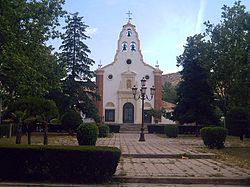Puertollano
| Puertollano | ||
|---|---|---|

The church of Santa Barbara.
|
||
|
||
| Location in Spain. | ||
| Coordinates: 38°41′N 4°7′W / 38.683°N 4.117°W | ||
| Country |
|
|
| Autonomous Community |
|
|
| Province | Ciudad Real | |
| Government | ||
| • Mayor | Mayte Fernández Molina | |
| Area | ||
| • Total | 226.74 km2 (87.54 sq mi) | |
| Elevation | 708 m (2,323 ft) | |
| Population (2009) | ||
| • Total | 51,842 | |
| • Density | 230/km2 (590/sq mi) | |
| Time zone | CET (UTC+1) | |
| • Summer (DST) | CEST (UTC+2) | |
| Postcode | 13500 | |
| Website | Official website | |
Puertollano is an industrial city in province of Ciudad Real, Castile-La Mancha, Spain. It is situated on the AVE High Speed Train line linking Madrid and Seville (opened 1992). The city has a population of 51,842 (2009).
The name of Puertollano is a concatenation of "puerto" (pass) and "llano" (flat). It is often said that "Puertollano is the town of two lies" ("Puertollano es el pueblo de las dos mentiras"), because of the polysemy of the Spanish word "puerto", which means both "pass" and "port". People often say that "Puertollano doesn't have a port neither it is flat" ("Puertollano ni tiene puerto, ni es llano"). It is partly built on the slopes of the surrounding Sierra Morena mountains.
Puertollano is the largest industrial center in the Castilla-La Mancha region. It was formerly a coal mining town but today only one open-cast mine remains. Nowadays the main industries are petrochemicals (REPSOL), fertilisers (Fertiberia), power generation and, most recently, the manufacture of solar panels. The city has received national and EU aid to diversify its economy after the decline of the coal industry.
Archaeological investigations have shown that the area was inhabited in prehistoric times (Homo heidelbergensis and Homo antecessor). Bronze Age weapons have been found and also a Visigoth necropolis from the post-Roman period.
Later the region formed part of the depopulated nomansland between Christian (Northern) Spain and the Moorish Caliphate to the south.
...
Wikipedia


